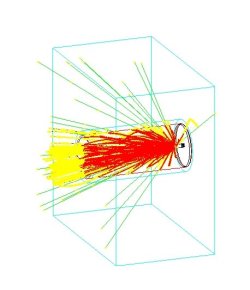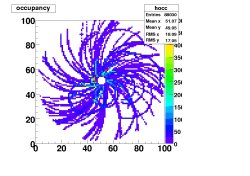Table of Contents
GEANT4 and other simulations are currently being done to model the TPC's response to simulated events.
induction in pads and movie
Simulation of the induction in the pixels of the detector of some of the partices in a violent collision. The gas is 1 atm of C4H10, the fiels is 2T, and the integration time in electronics is 0.2microsec.
Available systems
The event inputs are from imQMD simulations run by Zhang. We have limited systems available. A list of the currently available systems and energies can be found here:
In order to determine the specifications required for the electronics, simulations with maximum multiplicity and maximum energy deposition must be studied. Thus, we have simulated central collisions (b=2fm) at 150MeV/u and peripheral collisions (b=6fm) at 50MeV/u in the TPC.
GEANT simulations
Using the HEPEvt interface, the imQMD output was read into GEANT. First the ImQMD output is reformatted and processed using the statistical decay code called Gemini (GeminiHowTo.txt) Then the output of Gemini is reformatted to mimic a PYTHIA file as required by GEANT.
Simulated event: 124Sn, 50MeV, b=6fm, 1 event
From these simulations, we were able to determine the occupancy of the read out pads.
When the fragments are read into GEANT, all fragments heavier than an alpha particle are ignored. The the peripheral event (which has the largest fraction of heavy fragments), this amounts to ignoring 13% of the nucleons, or ~1% of the fragments. This should not significantly impact the pad occupancies. It does, however, dramatically effect the energy deposition in the pads. Thus, the heaviest fragment from the 50MeV, 6fm simulation was considered as a single particle passing through the detector. The occupancy numbers and energy deposition ranges can be found in the following chart.
Updated occupancy studies: The occupancy studies have been revisited with a more precise code, simulating the drift and diffusion of the ionization electrons through the gas. Plots showing these numbers for collisions at 150MeV, both central and peripheral can be found in the following presentation. THESE NUMBERS ARE THE ONES THAT SHOULD BE USED!
Beam particle identification
In order to take advantage of the beams available at the NSCL, the AT-TPC must have a detector capable of differentiating the nuclei present in the secondary beams. There are a wide variety of options for this detector. Details are presented on the following slides.


